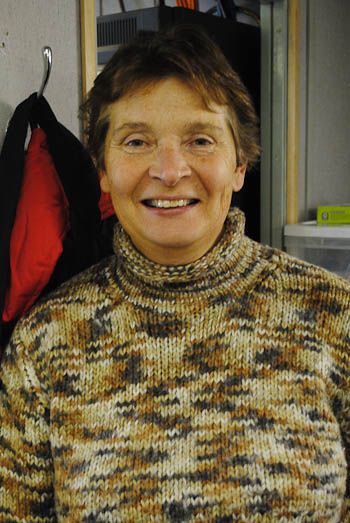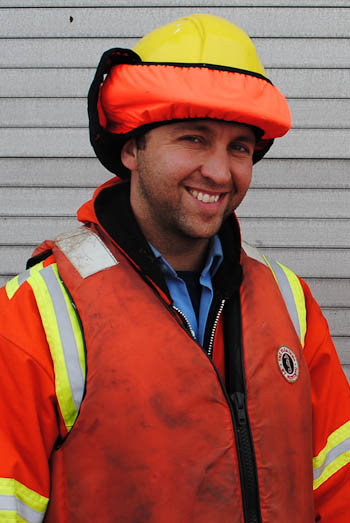Dispatch 13: Arctic Profiles |
| |
Alex KainSeptember 29, 2009
The 2009 Joint Ocean Study in the Beaufort Sea brings together an international team of scientists and crewmembers with varied interests and diverse backgrounds. Each participant arrived to working on an Arctic research vessel for unique reasons. Some knew from the time they were children that they wanted to study sea ice. Some came to the Arctic purely to satisfy a sense of adventure. Others joined the Coast Guard for purely pragmatic reasons, but now couldn't imagine any other lifestyle. Regardless of background, everyone now works in a team, united under common goals.
This is the first in a three-part profile series that will explore the diversity of crewmembers and scientists aboard the CCGS Louis S. St.-Laurent.
Name
Linda White
Hometown
Brentwood Bay, British Columbia
Affiliation
Fisheries and Oceans Canada – Institute of Ocean Sciences
What do you do on board?
I'm a chemist. I run nutrient samples on seawater, which we use to track the flow of material around the Arctic.
What is your academic background?
I graduated from the British Columbia Institute of Technology after specializing in soil analysis and agricultural chemistry.
How did you first become interested in the Arctic?
After thirteen years of staying home and raising children, I went back to work. In 2000 there was a spot available for me on an Arctic research vessel. That's where it all started.
On how many expeditions to the Arctic have you participated?
Nine, eight of which have been on the Louis. I had one last year to the Eastern Arctic around Greenland where I helped analyze oxygen samples.
Why is it important to study the Arctic?
It was once thought that nothing happened up here, that the Arctic was a giant scientific dead zone. Yet we've learned in recent years that the Arctic abounds with all kinds of biological and physical activity, much of which is still mysterious to science. Our specific work aims to track the currents that play into the flow of Arctic waters and that help explain the movement and distribution of natural chemicals, life forms, and ice around earth.
What is the greatest threat the Arctic faces in the next twenty years?
The warming of Arctic waters presents the biggest threat. Our research focuses on water circulation, trying to understand how the warming and diminishing ice pack affect global climate. Because the Arctic Ocean is covered in ice for most of the year, it doesn't have a chance to break down contaminants that enter the water. In essence, the Canada Basin is a giant sink. The Arctic is a very sensitive area. Moreover, Arctic contaminants recycle into local Inuit food and water supplies. A stark example of these disruptions is the contamination of mothers' milk.
What is people's greatest misconception about the Arctic?
They think it's unbearably cold all the time, but in the summertime it's actually quite pleasant. They think that there are a lot more animals up here and that every day we see pods of breaching whales. They don't realize that it's really a desert and that it's not as productive as other areas in the world.
Describe the Arctic in a few words.
Beautiful. Serene. Uncomplicated. Pure.
What's the first thing you do when you get home from a long trip to sea?
Besides hugging my husband, I take a long walk around my garden, pick flowers, bring the flowers into my house, sit there and enjoy being at home among my things.
When you're at sea, what do you miss about home?
I miss biking outside, sitting down with my husband every night with a good glass of wine, and talking about our days.
When you're home, what do you miss about the sea?
I miss the chance to focus on one thing without distraction, being an individual and pursuing my own projects in a supportive environment. I miss seeing the ice. I love it up here, and being up here only makes my home environment seem more vibrant. There's not a lot to see in the Arctic. The uniform landscape creates this intense contrast of color when you go home. After being in the Arctic, the world appears staggeringly beautiful. Flowers and colors jump at you. It's a very visual thing.
Describe the sound of ice crunching under the hull of the ship.
It's majestic. The blocks of ice are the size of buildings and cars. They possess this power and energy that create amazing explosions.
What's your favorite place on the Louis?
There are some chairs in the officers' mess hall where it's perfectly warm and a little dark. It's comfortable. I go there for a glass of juice every night before bed. There's also a spot on the deck outside the main lab where I watch the breaking ice and look for Arctic cod being flung to the surface. For me the ship is comfortable. I feel very fortunate to be here. Not many people on the planet come to this environment. It's a very special place.
* * * * *
Name
Barney Noseworthy
Hometown
Spaniards Bay, Newfoundland
Position
Coast Guard Deckhand
What are the primary responsibilities of your position?
I help maintain the safety and security of everyone on board the ship. To accomplish this, we keep up the interior and exterior of the vessel, especially in painting, facility maintenance, firefighting and prevention.
For how long have you been in the Canadian Coast Guard?
Two years.
How did you get involved with the Coast Guard?
Before joining the Coast Guard, I was a fisherman during the summer and a carpenter for the rest of the year. The fishing industry is going downhill in Newfoundland, so I got into the Coast Guard for something with more stability.
When did you first come to the Arctic? What were your first impressions of the environment?
This year. I found the environment outstanding. No words can explain. I love it up here.
What's the best thing about being a member of the Canadian Coast Guard?
The responsibility of knowing you could save someone's life—it would be an honor for a lifetime.
What have been some of your favorite memories and projects as a Coast Guard sailor?
Crossing the Arctic Circle, complete with an induction ceremony. Other than that, icebreaking to escort passenger ferries throughout the Outer Posts on the northeastern coast of Newfoundland.
What is people's greatest misconception about the Arctic?
People don't realize that you can really see the effects of global warming up here. A few guys in the Coast Guard will tell you that ice cover has significantly reduced in their time in the service.
Describe what it's like when you feel truly cold.
You can't feel your face no more. It's miserable and frozen, not nice, but we Newfey boys are used to it.
Describe the Arctic in a few words.
Amazing. Breathtaking. Beautiful.
What's the first thing you do when you get home from a long trip to sea?
Talk about polar bears with my two daughters; regretfully inform them that I searched for Santa Claus with no success.
When you're at sea, what do you miss about home?
Family.
When you're home, what do you miss about the sea?
The beauty and peacefulness of being on the water.
All text and photos property of Alex Kain unless otherwise indicated.
Last updated: October 7, 2019 | 



